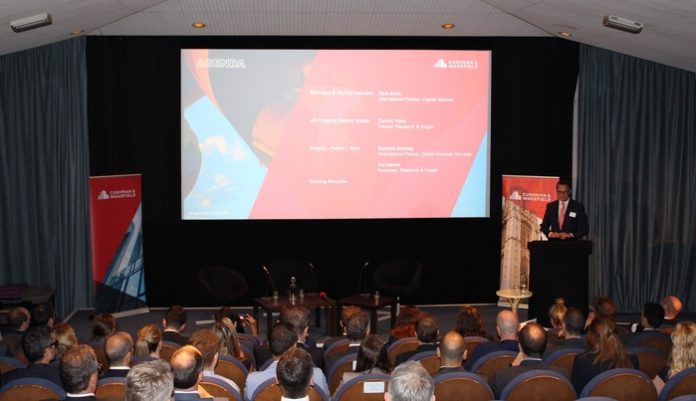Cushman & Wakefield has presented its Bristol Property Outlook for 2018 and beyond. The breakfast presentation, held yesterday at The Watershed in Bristol city centre, revealed that the commercial property market in the South West is well placed to benefit from changing market dynamics.
Nick Allan, International Partner and Head of Investment at Cushman & Wakefield’s Bristol office began the event with an overview of the South West property market and how it is set to perform this year and beyond which was followed by presentations from Darren Yates (Head of Retail Research & Insight), Kat Hanna (Insight Associate) and Richard Golding (Head of Occupier Services) on ‘People – People – Technology’.
Nick Allan said: “Bristol continues to thrive in many ways, driven by its attractive built and natural environment, as well as being a great city in which to live and work. However, population growth is putting a strain on the city’s housing and commercial markets by the significant lack of development across almost all sectors. Moreover, whilst there are a number of infrastructure projects ongoing, these fall someway short of the scale required to rectify decades of under investment in the city.
“Bristol’s overall positive message as a place to invest with the right market dynamics is bearing fruit, as we recently saw two of our most significant transactions attract major South Korean capital.
“The office and industrial leasing arena continues to witness strong rental growth, driven by healthy new entrants and organic occupier demand against a backdrop of limited supply, making it a landlord friendly environment. The housing and student accommodation markets continue to struggle to deliver the volume of units required by a growing audience and placing further pressure on above inflation growth.
“The investor background remains very strong, however we do require significantly more development in the office, residential and student sectors to balance and attract new investment and occupiers to grow in the city.”
Darren Yates followed with a presentation which discussed key trends in the commercial property market across the main sectors.
Economic and political uncertainty over the last year have made business planning extremely difficult, particularly for sectors like banking, the car industry and agriculture. However, last year also saw the second highest volume on record for commercial property investment with around £60billion worth of deals, driven largely by the industrial sector.
He said: “We are seeing a longer term trend which is the growth in industrial, leisure, alternatives and mixed-use, largely at the expense of retail. We’re also seeing an increasing shift towards mixed-use and a blurring of the traditional sectors.
“A more recent trend has been the slowdown in the shopping centre investment market, which reflects investor concerns around the structural changes going on in retail, particularly the secondary market.”
Kat Hanna and Richard Golding gave a thought provoking presentation on how dynamics between People, Power and Technology will have huge implications for the real estate sector.
Kat Hanna said: “It’s increasingly important that we understand as a sector how trends in online consumption and new business models are affecting demand for physical space. When it comes to sectors like retail, it is not as simple as online replacing physical. Rather, it’s about the blurring of activities taking place both online and in the physical world. The prize will go to those developers and landlords who understand how best to meet the needs of occupiers in this increasingly blended environment.”
Richard Golding added: “The speed and impact of disruption, for many occupiers, is part of their day to day operations. However, the real estate markets needs to adapt to support organisations who want to be agile, create flexible environments and deliver space that enhances productivity and retains the best people.
“Service, simplicity and speed is at the heart of everything they do, but the real estate dynamics aren’t always aligned to this. Some occupiers are having to look at alternative solutions and this will continue until the traditional market adapts.”





















